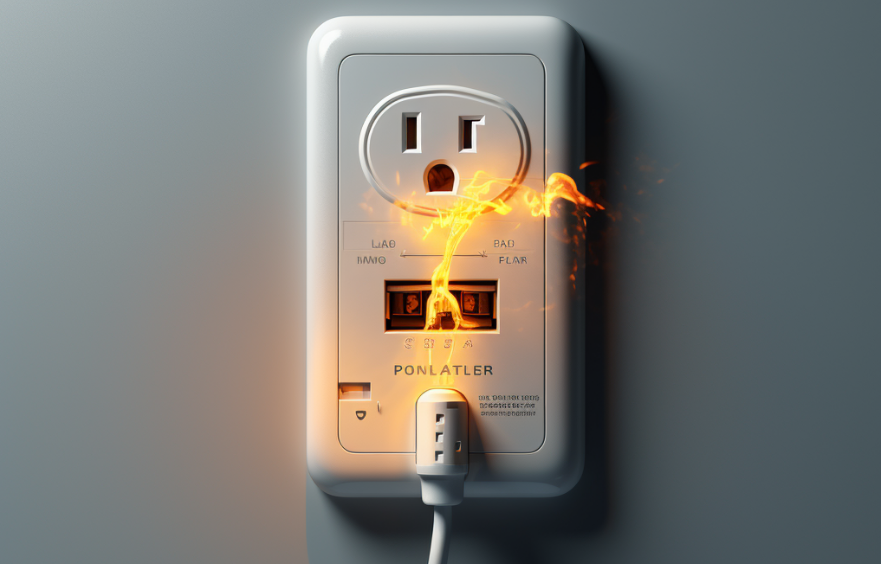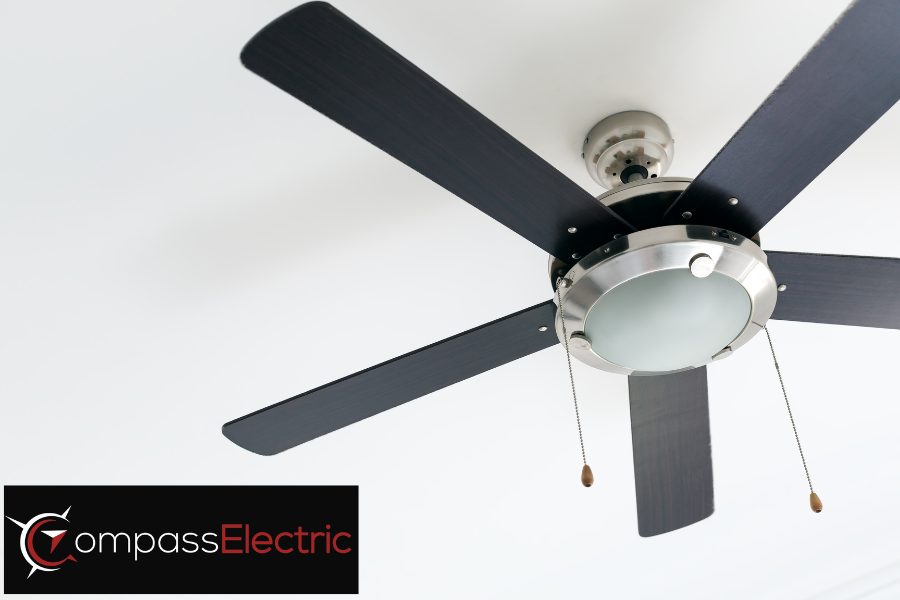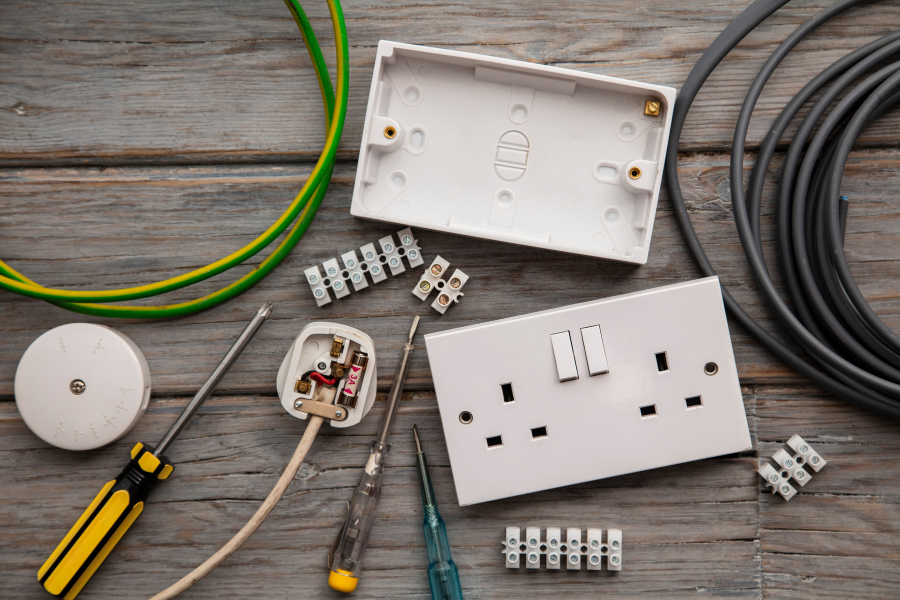Functional lighting is important for our daily activities. Whether it’s brightening up your work area or creating a comfortable ambiance at home, having reliable light fixtures is crucial. Dealing with a light that doesn’t work can be really annoying and disruptive.
Knowing the common causes of broken light fixtures can help you save time and money. In this article, we will share 7 effective solutions to common lighting problems:
- Burned-Out or Loose Light Bulbs
- Flattened Metal Socket Tab and Poor Contact with Bulb
- Issues with Wire Connections
- Overheating and Insulation Problems
- Faulty Limit Switches in Recessed Canister Lights
- Electrical Wiring Faults: Short Circuits and Loose Wires
By understanding these solutions, you can often fix lighting issues on your own without having to hire a professional. But if you’re unsure about anything, it’s always best to seek help from trusted electrical services.
If you’re looking for expert assistance in specific areas, such as EV charger installation in Cumming or cutting-edge electrical installation options in Roswell, consider reaching out to Compass Electric. They offer top-notch services in both these domains, including EV charger installation services in Cumming and innovative electrical installation options in Roswell. Additionally, if you’re based in Roswell and require comprehensive electrical services for your property, Compass Electric also provides premium electrical services.
Reasons for Failed Light Fixtures
1.1 Burned-Out or Loose Light Bulbs
One of the main reasons why light fixtures fail is because of burned-out or loose light bulbs. When a bulb burns out, it can no longer complete the electrical circuit needed to produce light. Similarly, if a bulb is not securely in place in its socket, the connection can be intermittent and result in flickering or complete loss of light.
Steps to Check and Replace Light Bulbs:
- Safety First: Always make sure the power is off before working on any electrical fixture.
- Inspect the Bulb: Remove the bulb and visually inspect it for signs of burnout, such as a broken filament or dark areas inside the glass.
- Test with a New Bulb: Replace the suspected bulb with a new one that has the recommended wattage for the fixture.
- Secure Fit: Make sure the new bulb is screwed in tightly but be careful not to overtighten and damage the socket.
By following these steps, you can often quickly and easily fix lighting problems caused by burned-out or loose bulbs.
Related Services for Electrical Issues:
If replacing the bulb doesn’t solve your problem, consider seeking professional help. For example, Compass Electric offers expert switch and outlet installation services in Canton.
1.2 Flattened Metal Socket Tab and Poor Contact with Bulb
The metal tab at the bottom of a light socket plays an important role in making sure there’s good electrical contact with the bulb. Over time, this tab can get flattened from repeatedly screwing in bulbs, which leads to poor contact and a non-working fixture.
Fixing Flattened Metal Socket Tabs:
- Power Off: Always start by turning off the power to avoid any electrical dangers.
- Adjust Tab: Using a small tool like a screwdriver, gently lift the metal tab to restore its original position.
- Reinstall Bulb: Screw in a new or working bulb securely to ensure there’s good contact.
Addressing this issue can often restore functionality to your light fixture without much effort.
1.3 Issues with Wire Connections
Secure wire connections are crucial for maintaining a continuous electrical circuit. Loose wires at any point—whether at the switch, fixture, or electrical box level—can interrupt this circuit and cause your light to stop working.
Ensuring Tight Wire Connections:
- Turn Off Power: Safety first; make sure there’s no current running through the wires you’re working on.
- Inspect Connections: Open up switches and fixtures to check for any loose or disconnected wires.
- Tighten Wires: Use the right tools to secure any loose connections you find.
- Test Fixture: Restore power and test your light fixture to see if it’s functioning correctly.
For more extensive wiring repairs, Compass Electric offers reliable services tailored to meet your needs.
By understanding these common reasons for failed light fixtures and knowing how to address them, you can often solve these issues without extensive effort or expense. Practical solutions like replacing burned-out bulbs or adjusting socket tabs are straightforward yet effective methods you can use immediately.
If you’re facing more complex electrical problems such as faulty wiring or require [cable wiring installation](https
1.2 Flattened Metal Socket Tab and Poor Contact with Bulb
A common issue in failed light fixtures is the flattened metal socket tab. This small but crucial component plays a vital role in ensuring that the bulb makes proper contact with the electrical circuit.
Understanding the Role of the Socket Tab
The metal tab at the bottom of the socket is responsible for connecting the bulb’s base to the power source. If this tab is flattened, it prevents a secure connection, leading to flickering lights or complete failure.
Solutions: Fixing Flattened Metal Socket Tab for Better Connection
- Turn Off Power – Always start by turning off the power to avoid any electrical hazards.
- Check and Adjust – Use a non-conductive tool like a wooden stick or plastic utensil to gently bend the tab upward.
- Reinstall and Test – Reinsert the bulb and turn on the power to see if the light works properly.
Addressing this minor adjustment can often restore functionality without more extensive repairs. For professional assistance with more complex electrical issues, consider reaching out to experts like Compass Electric who offer reliable services including ceiling fan repair in Canton, ensuring optimal performance and comfort in your space. They also specialize in EV charger installation in Marietta, providing fast, reliable, and affordable solutions for all your electric vehicle charging needs.
Ensuring proper contact through a well-positioned socket tab can save you time and frustration when dealing with non-working light fixtures.
1.3 Issues with Wire Connections
Secure wire connections are crucial for maintaining a working circuit in any light fixture. Loose wire connections can lead to intermittent power flow, causing your lights to flicker or stop working entirely. These issues often arise at various points within the electrical system, such as the switch, fixture, or electrical box.
Solution: Ensuring Tight Wire Connections
- At the Switch: Turn off the power at the circuit breaker before inspecting the switch. Remove the switch cover and check for any loose wires. Tighten any loose connections and ensure that all wires are securely fastened to their respective terminals.
- At the Fixture: Carefully remove the light fixture to inspect the wiring inside. Look for loose or disconnected wires and use a wire nut to secure them tightly together.
- At the Electrical Box: Open the electrical box cover and examine the connections. Tighten any loose wire nuts and make sure all wires are securely connected.
Regularly checking these connections can help you avoid many common issues that cause light fixtures to fail. For professional assistance or if you encounter complex wiring problems, reaching out to a trusted electrician is recommended.
For those in need of expert help, consider contacting Compass Electric, a top-rated electrician service in Metro Atlanta specializing in electrical installation, repair, and service. Their experienced team can provide guidance on wire connection maintenance and address any complex wiring problems you may encounter.
Proper maintenance of wire connections ensures that your light fixtures operate smoothly and effectively, reducing downtime and avoiding potential hazards associated with faulty electrical components.
1.4 Overheating and Insulation Problems
Using bulbs with wattage exceeding the fixture’s recommended limit can lead to overheating issues. Overheating not only poses a fire risk but also shortens the lifespan of your light fixtures and can cause burned-out light bulbs more frequently.
Risks Associated with Higher Wattage Bulbs:
- Fire Hazards: Excessive heat from high-wattage bulbs can cause nearby materials to ignite.
- Shortened Fixture Lifespan: Prolonged exposure to high temperatures can degrade fixture components, leading to failure.
- Frequent Burnouts: Overheating accelerates the burnout rate of bulbs, causing them to fail sooner.
Addressing Insulation Issues:
Insulation packed too tightly around a light fixture traps heat, exacerbating the overheating problem. Ensuring proper ventilation around your fixtures is crucial.
Steps to Mitigate Overheating:
- Check Bulb Wattage: Always use bulbs that match or are below the fixture’s recommended wattage.
- Inspect Insulation: Make sure insulation is not suffocating the fixture, allowing for adequate heat dissipation.
- Proper Installation: Ensure that light fixtures are installed correctly and not surrounded by excessive insulation.
For professional assistance in resolving overheating and insulation issues, consider reaching out to experts like Compass Electric for reliable electrical services in Mableton. They have extensive experience in providing exceptional electrical services in Mableton and can offer reliable and efficient solutions. If you’re looking for cost-effective solutions, you can also check out their electrician specials in Atlanta which can help you save money on your electrical repairs and installation on your home.
Addressing these problems can significantly enhance the longevity and safety of your light fixtures, making them more reliable in the long run.
1.5 Faulty Limit Switches in Recessed Canister Lights
Faulty limit switches can be a significant cause of recessed canister lights shutting off unexpectedly. Limit switches are safety devices designed to cut off power when the fixture overheats, protecting both the light and your home from potential fire hazards. However, these switches can sometimes malfunction, leading to frequent and unexpected shut-offs that disrupt your lighting.
Understanding Limit Switch Issues:
- Functionality: Limit switches monitor the temperature within the recessed canister light. When they detect excessive heat, they interrupt the electrical circuit to prevent overheating.
- Common Problems: Over time, limit switches may become overly sensitive or fail completely, causing your lights to turn off even under normal operating conditions.
Troubleshooting and Solutions:
- Inspection: Begin by turning off the power and inspecting the limit switch for any visible signs of damage or wear.
- Resetting: Some limit switches may have a manual reset option. Refer to your fixture’s manual for specific instructions on how to reset it.
- Replacement: If troubleshooting doesn’t resolve the issue, it might be necessary to replace the faulty limit switch. This task requires careful handling of electrical components.
For professional assistance with electrical issues in East Cobb, including reliable and efficient services, consider Compass Electric. They specialize in electrical installation and maintenance, ensuring that your recessed lights function smoothly without unexpected shutdowns.
1.6 Electrical Wiring Faults: Short Circuits and Loose Wires
Short Circuits
Short circuits are one of the most dangerous issues that can cause your light fixtures to fail. When “hot” and “neutral” wires come into contact, it can lead to faulty wiring, causing the light to stop working and posing a significant fire hazard.
If you suspect a short circuit, it’s crucial to seek professional help immediately. Licensed electricians, like those at Compass Electric, have the expertise to safely resolve these problems and ensure your home’s electrical system is secure.
Loose Wires
Loose wires are another common culprit behind malfunctioning light fixtures. Improper installation or amateur electrical work often leads to loose connections, which can disrupt the circuit and prevent the light from functioning correctly.
Ensuring that all wire connections at the switch, fixture, or electrical box level are tight is critical for maintaining a reliable lighting system.
Other Contributing Factors
In addition to short circuits and loose wires, other factors that can contribute to failed light fixtures include:
- Bad sockets
- Failed wall outlets
Over time, wear and tear can cause these components to fail, necessitating replacement to restore functionality.
For more information on handling such issues professionally in Canton, GA: Panel Repair – Compass Electric
Proper installation techniques help avoid many of these issues, ensuring long-lasting and safe lighting solutions in your home.
Conclusion
Experiencing a non-working light can be frustrating, but the solutions discussed here offer practical steps to troubleshoot and resolve common issues. Before seeking professional assistance, try these proven solutions for non-working lights:
- Check and replace burned-out or loose light bulbs.
- Fix flattened metal socket tabs for better contact.
- Ensure tight wire connections at switches, fixtures, and electrical boxes.
- Address overheating issues by using proper wattage bulbs and ensuring adequate insulation.
- Troubleshoot or replace faulty limit switches in recessed canister lights.
- Resolve electrical wiring faults such as short circuits with professional help if needed.
By addressing these common problems, you can restore functionality to your light fixtures and avoid the hassle of frequent repairs.
For more comprehensive electrical solutions, visit Compass Electric for expert advice and services. If you’re dealing with outlet or switch issues in Canton, GA, consider their specialized Outlet Repair Switches services offered in the area.
Taking these steps can save you time and effort while ensuring your home remains well-lit and functional.
FAQs (Frequently Asked Questions)
What are some common reasons for failed light fixtures?
Some common reasons for failed light fixtures include burned-out or loose light bulbs, flattened metal socket tab, issues with wire connections, overheating and insulation problems, faulty limit switches in recessed canister lights, and electrical wiring faults such as short circuits and loose wires.
How can burned-out or loose light bulbs result in a non-working light fixture?
Burned-out or loose light bulbs can result in a non-working light fixture by interrupting the flow of electricity needed to illuminate the bulb. This can lead to a lack of functionality in the entire light fixture. The solution is to check and replace light bulbs to restore functionality.
What is the significance of a flattened metal socket tab in causing failed light fixtures?
A flattened metal socket tab can cause failed light fixtures by preventing proper contact with the bulb, leading to a disruption in the electrical connection. It's important to understand the role of the socket tab in establishing proper contact, and the solution is to fix the flattened metal socket tab for better connection.
Why are secure wire connections important for maintaining a working circuit in light fixtures?
Secure wire connections are important for maintaining a working circuit in light fixtures because they ensure the continuous flow of electricity needed for proper functionality. Loose wire connections can disrupt this flow and result in non-working light fixtures. The solution is to ensure tight wire connections at the switch, fixture, or electrical box level.
What are the risks posed by using bulbs with wattage exceeding a fixture's recommendation?
Using bulbs with wattage exceeding a fixture's recommendation can lead to overheating and insulation problems. This poses a risk to both the functionality of the light fixture and potential fire hazards due to excessive heat buildup. The solution is to address overheating due to insulation issues around the light.
How do faulty limit switches impact recessed canister lights?
Faulty limit switches can cause recessed canister lights to shut off unexpectedly, disrupting their normal functionality. Understanding how these switches work and their potential issues is crucial in addressing non-working recessed lights. The solution involves dealing with limit switch problems through troubleshooting or replacement.
What are some potential dangers associated with electrical wiring faults such as short circuits and loose wires?
Electrical wiring faults such as short circuits and loose wires pose dangers such as disruption of light fixture functionality, potential fire hazards, and electrical safety concerns. Resolving short circuits with professional help if needed is crucial, as well as ensuring proper installation to avoid issues like loose wires and bad sockets.






